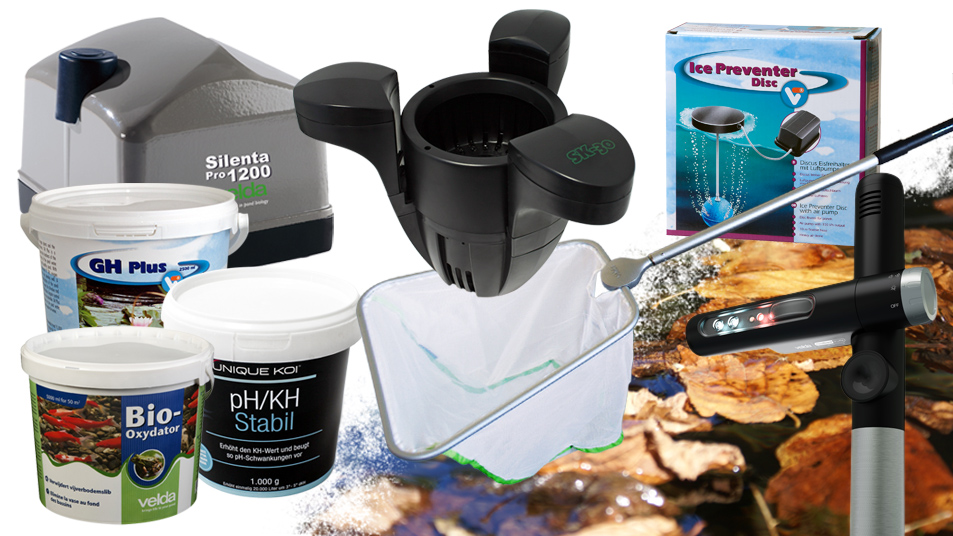Maintenance of your pond in autumn
During the months of September, October and November the garden pond gradually comes to settle down and rest. It is precisely the time when plants and creatures prepare for the winter season and wait for the pond owner´s helping hand to support them during this process. Learn more about: Maintenance of your pond in autumn.
The following enumeration may give you an idea about the important tasks to be fulfilled in autumn:
- Fishing and collection of leaves and plant particles
- Stretching a protecting foliage net across the pond
- Cleaning all technical devices and providing for a frost-free storage
- Drainage of hoses
- Storage of pond plants that are not in the condition to be sturdy during the winter season
- Thinning out floating and submerged plants
- Tying up grasses and reeds
- Removal of digested sludge
- Making use of an ice preventer
Fishing leaves / Stretching a pond net
By stretching a pond net across the garden pond, you can save a lot of work in the season of autumn. The pond net ensures that the foliage falling down does not end up in the pond water. Died off leaves as well as particles from plants should be regularly removed by the means of a pont net to provide for the sufficiently required water quality. Plant particles rot away in water, this submitting substances that disturb the pond´s biological balance. This results in fermentation gases beneath the layer of ice in winter whereas in spring there will be a strong growth in algae. The fermentation gases may cause the pond inhabitants to suffocate. An accurate preparation of the pond for the winter season contributes to the health of your fish. So you make sure to take much pleasure in the pond with regard to the forthcoming season.
The installed pond net should be removed before the first overnight freezes and as soon as the leaves have stopped falling down.
Frost-free storage and cleaning of technical devices
The growth of algae in the pond stops at temperatures below 10°C. So there is no need for pond technology during winter. For the maintenance of the pond in autumn, pumps and filters should be removed from it. Freezing water expands, thus generating a strong pressure which in turn damages the technical devices. Clean thoroughly all pump and filter elements and inspect them thoroughly for damage before storage. The storage should be in a frost-free place (e.g. in the cellar). Store the pump in a bucket of water in order to prevent the pump from drying which makes the essential gaskets made of plastic become brittle and porous.
The hoses being used should be thoroughly emptied so that they are not damaged due to frost.
Cultivation of plants = Maintenance of your pond in autumn
In case your garden pond is not as deep as to resettle sensitive plants to frost-free zones, it is advisable to put them in a cool but frost-free place during wintertime. We recommend the cellar or an adequate glasshouse.
Grasses and reeds should be tied up and cut back if necessary. Reeds, cattails and other pond plants should be cut shortly above the water surface. You may also wait to cut the dry stems in spring if you like. There are insects that use the reeds to settle down in winter. The plants provide for an exchange of gas in the garden pond.
Ideally, water lilies and other floating plants are cut with a special pond scissors as far below as possible. Plant remains should be thoroughly removed to the effect that they do not cause a digested sludge on pond´s ground. The special cutting tool has a long handle thus enabling to work from the edge of the pond. The plant residues can be easily removed with a landing net.
Removal of digested sludge
Especially in wintertime, the digested sludge is a problem and much wor for the maintenance of your pond. The process of putrefaction releases poisonous hydrogen sulphide gas that cannot escape the frozen pond and therefore gradually dissolves in the water. It is recommended to remove the digested sludge before wintertime with a bailer or be the means of an electric sludge sucker. The sludge can either be put on compost in thin layers or used as a fertilizer on the flower bed.
Use of an ice preventer
During wintertime fish move into the deeper water areas. It is a kind of hibernation that makes them remain there until spring. It is not only that their heartbeat slows down to approximately one beat per minute but also their metabolism nearly goes to a halt. Being in a hibernation, fishes are low on oxygen and renounce any food.
The creatures are in danger only by freezing or suffocation due to lack of oxygen or a high level of fermentation gas in the water. At a water depth of at least 80 cm the danger of freezing can be excluded whereas lack of oxygen or formation of digester gas can remain a problem when there is a closed layer of ice. This is why it is advised to make use of the so-called ice preventers. They should be used just in time before the formation of ice in the pond.
If you have failed to make use of the ice preventer in time you should not break up the water surface by force. Pressure and sound waves disturb the fish during hibernation. You better make the ice melt by using a hair dryer or hot water.
For the maintenance of your pond it is important that below a temperatures of 12°C you should refrain from feeding the fish. Due to the slow metabolism, the food cannot be digested anymore and leads to death.

Leave a Reply